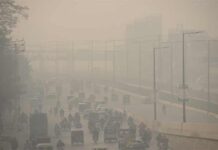Polycyclic aromatic hydrocarbons (PAHs) are the hazardous chemicals that contaminate the atmosphere both in the vapour phase and condensed form, deposited on water, soil and plants. Their accumulation and persistence in the environment can produce harmful effects because of their mutagenic and carcinogenic properties.
The potential health impacts of PAHs on human and animals necessitate the conduction of toxicological assessment studies regarding the prevalence of PAHs in conjunction with the application of successful remediation techniques for the degradation of PAHs. Dr. Abdul Muqeet Khan, a PhD Scholar, Institute of Biochemistry and Biotechnology, UVAS, Lahore under supervision of Dr. Muhammad Imran, Associate Professor (Tenured) carried out research to address the said dilemma.
Soil, water and blood samples of humans, as well as animals from suspected areas such as industry-linked areas (Pharmaceutical, Textile, Leather tanneries), areas near high-ways, and waste combustion areas, were collected around Lahore city, Punjab, Pakistan to quantify six selected PAHs (Phenanthrene, Biphenyl, Biphenanthrene, Naphthalene, Anthracene and P-Ansidine). The highest average concentration of Naphthalene was detected in samples from industrial areas. Meanwhile, the lowest average amount of Biphenanthrene was found in samples from highways. Human and animal plasma samples were also found to carry PAHs in comparatively lower levels than soil and water.
Different treatments were applied for the degradation of PAHs in soil and water samples by using Bacillus bacterial specie, Corncob, pomegranate peels and Rice husk. Organic acids (citric acid, acetic acid, oxalic acid, lactic acid) were also employed for the degradation. Overall results were fruitful but Hydrolysis with organic acids (lactic acid, citric acid and acetic acid) was quite satisfactory.
Filters were prepared to control or minimize the exhaust of PAHs. After the Biochemical degradation was completed, a technique was selected which shows maximum degradation for the development of an absorbent filter. In the current study, manufacturing of three types of filters (Electrostatic based, Pomegranate peel based and birds feathers based) was carried out. Their efficiency was tested to remove molecules bounded PAHs and also other genotoxic compounds associated with these particles. The electrostatic filter was more efficient as compared to pomegranate peel based and bird’s feathers based filters. In short, the present data supports the possibility of PAHs and their related genotoxic particles exclusion from the environment via agricultural waste-based filters.
DR ABDUL MUQEET KHAN AND DR MUHAMMAD IMRAN
LAHORE






















